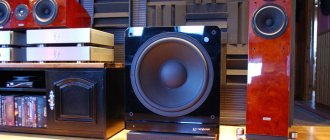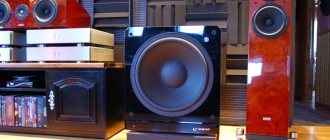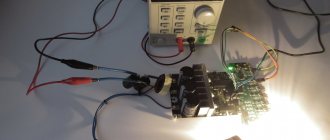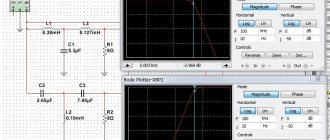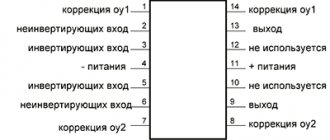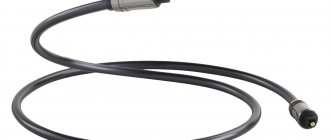Manufacturers of modern TV models have been able to ensure that the reproduced audio signal is clear and loud. But not all owners are satisfied with the standard sound and there is a need to output sound to an external media device, for example, a home theater.
S/PDIF is an international standard for digital audio transmission. Data transfer is realized through several cables and connectors. It was first used in audio players. But the technology began to develop and the S/PDIF mode appeared on home theaters, car radios, personal computers and modern TV models.
History of the creation of S/PDIF
It is worth noting that S/PDIF is the brainchild of Philips and Sony. The interface was created on the basis of the AES/EBU professional level standard, but took on a more simplified appearance. From the very beginning it was planned that using S/PDIF it would transmit sound only from CDs. There was also talk exclusively about stereophony. But gradually the interface was refined, and the number of supported formats was constantly growing. As a result, the standard learned to work with 7.1 and 5.1 sound. In this case, the stream is compressed and reconstructed using a decoder.
Protocol [edit | edit code]
S/PDIF can be used to transmit digital signals in a variety of formats. The most common of these are the format used in DAT with a sampling rate of 48 kHz and the CD recording format with a sampling rate of 44.1 kHz. In order to support both of these systems, the format does not have a specific data bitrate. Instead, data is transmitted using Biphase Mark Code, which has one or two transitions for each bit of data, allowing the original word clock to be transmitted along with the signal itself.
Extending the capabilities of this interface, S/PDIF can be used to transmit 20-bit audio data streams plus other related information. It is also possible to transmit 16-bit streams with zero padding or 24-bit streams, at the expense of omitting additional information.
The low level protocol is almost the same as in the AES/EBU description. The only difference is the channel status bit.
Channel status bit in S/P-DIF [edit | edit code]
Each sub-frame has one channel status bit, resulting in a 192-bit word in each audio block. This means that there are 192/8 = 24 bytes available in each audio block. The meaning of the channel status bit in S/PDIF is completely different from AES/EBU.
Operating principle and characteristics of S/PDIF
S/PDIF itself is implemented using a “tulip” (RCA) and an electrical (coaxial) cable, where the resistance is 75 Ohms. Such a cord will be an ideal option if the distance between devices is two meters or more. For the shortest possible distances, regular RCA-RCA is also suitable. At the same time, the most progressive option today seems to be the connection option via a fiber optic cable using a laser beam (TOSLINK or OpticalOut).
As noted, S/PDIF is designed to work with stereo audio, but now supports compressed multi-channel audio. This was made possible by expanding the permissible speed from 150 kilobytes per second to 1.536 megabits per second. It uses pulse code modulation to transmit sound. Moreover, the information is split into separate packets (32 bits), and the free space in them can be filled with zeros. In addition to the sound itself, data is transmitted about the number of channels, as well as the track number.
Concept
Interestingly, the international standard allows for both S/PDIF and S/P-DIF options.
It has its own decoding, which lets us understand who developed this standard. Sony/Philips Digital Interface Format stores a set of protocol parameters with hardware implementation. It has the ability to transmit digital sound from the first audio device to the second. Considering S/PDIF, we will understand its physical and system parts. The physical parameter makes it possible to find out which way the signal is transmitted and through which channels, and the system parameter - which protocol is used.
Types of S/PDIF
Today S/PDIF is implemented in several forms:
- Electric. In this case, a coaxial cable is used, the resistance of which at the input and output reaches 75 Ohms. It connects using RCA connectors. At a distance of up to half a meter, you can use a standard tulip audio cable. Its output voltage is 1 volt p-p, under load - 0.5 volts. If a long cable is used (more than 5 meters), there may be losses.
- Optic. Fiber optic cable (TOSLINK) is involved. This option is distinguished by the operation of a laser beam that does not fade even at significant distances. Particularly popular is the MiniTOSLINK connector, which is very often found in various laptops. it combines headphone and S/PDIF outputs.
Normal motherboard temperature
The temperature of the motherboard is the most important indicator that needs to be constantly monitored, especially in the summer, when the mercury temperature reaches +30 degrees and above. The operation of all main components of the board is accompanied by heat generation (the processor and graphics card heat up the most). Moreover, the temperature of the motherboard and its components is not a constant indicator. When performing complex tasks, for example, running modern games or mining, working with resource-intensive applications, the temperature of the motherboard increases significantly.
If critical indicators are exceeded, the mosfets on the motherboard burn out, and if the overheating is very strong, the transistor may even melt and literally stick to the board, which leads to the destruction of the conductors located under the SMD element - multilayer printed circuit boards (and all motherboards are multilayer) restoration are not subject to You can replace swollen capacitors, microcircuits and other elements in them, but if the tracks are seriously damaged, repairs (even if possible and if you find a master who will undertake such jewelry work) will cost you more than purchasing a new component.
To protect your equipment from overheating, change the thermal paste on the processor in a timely manner, regularly clean the system unit from dust, and install good fans in the system unit case. It is also recommended to regularly monitor the temperature of the motherboard using special utilities (AIDA64, GPU-Z, Everest and others). What temperature can be considered normal? Focus on the indicators recommended by the manufacturer. But in any case, temperature above 70 degrees is considered critical.
If the red light on the motherboard is on, we recommend that you refer to the documentation for the specific model of the component. The fact is that manufacturers use various solutions for light indication of errors. Therefore, in some boards the indicator lights up when there is physical damage, in others it warns of overheating, and in others this is normal mode.
In what technology can you find an S/PDIF output?
In the beginning, this output could be found in CD players and DVD players into which discs were inserted.
However, over time, it began to be used in many audio devices. The output is available in TVs, players, sound cards for PCs, car radios, and home theaters.
Features of S/PDIF output on TV
The S/PDIF output on this device is required in order to output and transmit audio in the required format. When there is a high-quality broadcast on TV and the 5.1 format is supported, the equipment outputs sound in optical or digital format. Modern TV models are usually equipped with coaxial or Toslink connectors.
Common questions related to updating drivers
As for updating the software that controls the audio equipment, do not use the system tools (it will still be a waste of time). It is better to give preference to, say, Driver Booster-class utilities from iObit or DriverPack Solution online modification.
If the problem is not resolved, in the “Device Manager”, find information on the identifiers of the problematic devices (VEN and DEV), as shown in the image above, and then search for them either on the website of the equipment manufacturer (laptop or motherboard, if you are talking about about integrated cards), or on resources specially designed for this, then download the required version of the driver, taking into account the architecture of your OS, and install it manually.
How to choose the right S/PDIF cable, which is better, coaxial or optical?
When purchasing, you should pay attention to the length of the cable. Without the use of an appropriate signal amplifier, it should be no more than five meters. In addition, it is important to pay attention to which tape is supported by the selected cable. The optimal range is considered to be from 9 MHz to 11 MHz. The higher the numbers, the better the cable material. It is worth noting that products made from borosilicate glass are more valued. Plastic is considered a simpler option.
For any type of connection, the transfer of information is the same. There is no big difference in transmitting via optics or electricity. However, the latter option is more common and accessible. Fiber optics are a little more difficult to find, especially if you look in your supplies. But there are adherents of the theory that optical connections suffer less from interference. Therefore, it is easier to use when many other electronics are connected. Its disadvantages include fragility during installation. It is preferable to twist such a cable into a wide loop. If you lay it at sharper angles with turns, then you should pay attention to the coaxial cable. As for range, both options are identical. Their maximum transmission distance is represented by the figures 10 meters. The advantages of optics here include the fact that from 5 meters the laser beam will not attenuate, unlike an electrical signal.
What to do with integrated HD Audio devices?
If the above steps did not give any effect, call the “Device Manager” and look at the status of the equipment that needs to be used. If it is disabled, activate it through the RMB menu. If drivers are missing or problems with their functioning are identified, you should not update them using system tools.
It is better to remove all existing problematic components from the system, including their drivers, and then perform a complete restart of the system. In theory, Windows will install new drivers itself. If you have the original driver disk that came with the purchase of your computer or laptop, it is better to install the appropriate software from it.
TOSLINK and S/PDIF: what is the difference
This interface works with a TOSLINK fiber optic connector or coaxial cable with RCA connectors. The actual signal is the same for both options. But TOSLINK on coaxial cable has higher signal instability. S/PDIF is most often associated with optical fiber, since it is more modern and in demand.
Pros and cons of S/PDIF
Advantages:
- Transmits surround sound in compressed form.
- Transmission of lossless stereo sound in PCM format.
- Spdif is almost immune to external influences.
- Relevant when connecting equipment with HDMI interfaces is unavailable.
Flaws:
- Limited bandwidth.
- It is not capable of transmitting DTS-HD Master Audio and Dolby TrueHD streams.
Activation of integrated cards in primary systems
Now let's see what else can be done if there is still no sound when using S/PDIF digital audio. It is possible that the primary audio device is disabled in the primary BIOS.
At the reboot stage or when turning on the computer, enter the BIOS, then move to the Advanced settings section or use the Onboard Devices menu, find your sound adapter there and enable it, if for some reason it turns out to be disabled, install the parameter for it is Enabled.
If the sound card is not in the list at all, check the connection of the card to the motherboard (for removable devices). In the case of integrated adapters, it is, of course, better to test the entire board. However, this is not always required. The easiest way to update the BIOS is by downloading the latest firmware from the developer’s official website. If you have an updated UEFI interface, you can install it directly from Windows, but in the case of a regular BIOS, you will have to create a special bootable media and/or use the tools of the primary system itself, if it provides them.
Is there a future for S/PDIF output?
S/PDIF output is inferior to some modern audio transmission methods in terms of small audio transmission and data transmission distance. It can be used in individual cases when it is necessary or there are no other options. Most often, the connector is used for compatibility with equipment of previous generations. Thus, it will be relevant for connecting analog speaker systems, various VCRs, as well as DVD players and other devices. At the same time, S/PDIF remains relevant due to the fact that it is much cheaper compared to HDMI eARC. If the user does not purchase expensive acoustics, then he will not notice the disadvantages of this interface.
Using the diagnostic tool
You may be interested in: How to create an M3U playlist for music, video and TV channels?
Now let's start troubleshooting possible problems. If there is no sound when using an S/PDIF digital audio device, in Windows 7 and newer operating systems, the first thing to do is to use the built-in diagnostic tool for detecting and fixing problems, which is located in the Control Panel.
Many users clearly underestimate it, believing that it usually does not eliminate the identified problems. But you actually don’t need this! In this case, it is much more important to identify the exact cause, and this tool is perfect for this (even if it cannot fix the identified problems on its own). Once the report is shown, you will know exactly what to do next.
Bibliography
- J. Watkinson, The Art of Digital Audio, Third Edition
, Focal Press, 2001
| Wireless | WirelessHD • Wireless HDMI • Wireless Home Digital Interface |
| Little used wired | Mini-VGA • Mini-DVI • Micro-DVI • DFP • DMS-59 • D-Terminal • Apple Display Connector • CGA • MDA • Tandy • HGC • EGA • DB13W3 • SDI • ASI |
| To transmit audio signal | |
| Household | RCA • TRS (Jack 3.5 mm, Jack 2.5 mm) • DIN • S/PDIF |
| Professional | XLR • TRS (6.35mm Jack) • Speakon • BNC • D-sub |

